Introduction
Choosing the right inventory management software can feel like hunting for a needle in a digital haystack.
With so many options available, how do you pick the one that’s best for your business? Don't worry! We've done the legwork for you.
Whether you're a retail guru, an e-commerce maestro, or running a bustling cafe, keeping tabs on your stock levels can be as crucial as your morning coffee.
Here’s a rundown of the top 8 inventory management software platforms, broken down in a way that’s easy to digest for even the most casual business enthusiast.
1. Sanka

Sanka isn’t just any tool. It's an integrated commerce management platform designed to handle a wide array of business operations including procurement, inventory management, orders, shipping, and billing.
Think of Sanka as your business's central command center, where every crucial operation happens smoothly and cohesively.
Key Features:
- Purchase Orders & Inventory Management: Keep stock levels optimal, and make reordering a breeze.
- Orders & Shipping: Streamline how orders are processed and shipped, improving customer satisfaction.
- Invoices: Generate and manage invoices with ease, ensuring financial matters are always in order.
- Customer Management: From acquiring leads to nurturing customer relationships – it's all covered.
- Work Management: Tasks, projects, workflows, and data integrations are neatly wrapped in this feature to keep your team productive.
- Integrations: Sanka plays well with others, including Shopify, Amazon, Stripe, HubSpot, and more, ensuring seamless operations across your tools.
Best For:
Business owners and managers weary of juggling multiple platforms or drowning in Excel sheets.
Sanka is ideal for small to medium-scale businesses aiming to streamline their operations under a single roof, enhancing efficiency and clarity across the board.
Plus:
- User-Friendly: Designed to get things done faster, without the steep learning curve.
- Cost-Effective: Eliminates hidden fees and the burden of long contracts; offers a free tier and affordable monthly subscriptions.
- Comprehensive Solution: Covers a wide range of commercial operations, reducing the need for multiple tools.
Minus:
- Adaptation Time: Newcomers to integrated management platforms might require some time to explore and fully utilize all the features.
- Broad Focus: For businesses needing highly specialized tools for specific operations, Sanka’s comprehensive approach might necessitate additional custom development.
2. Zoho Inventory
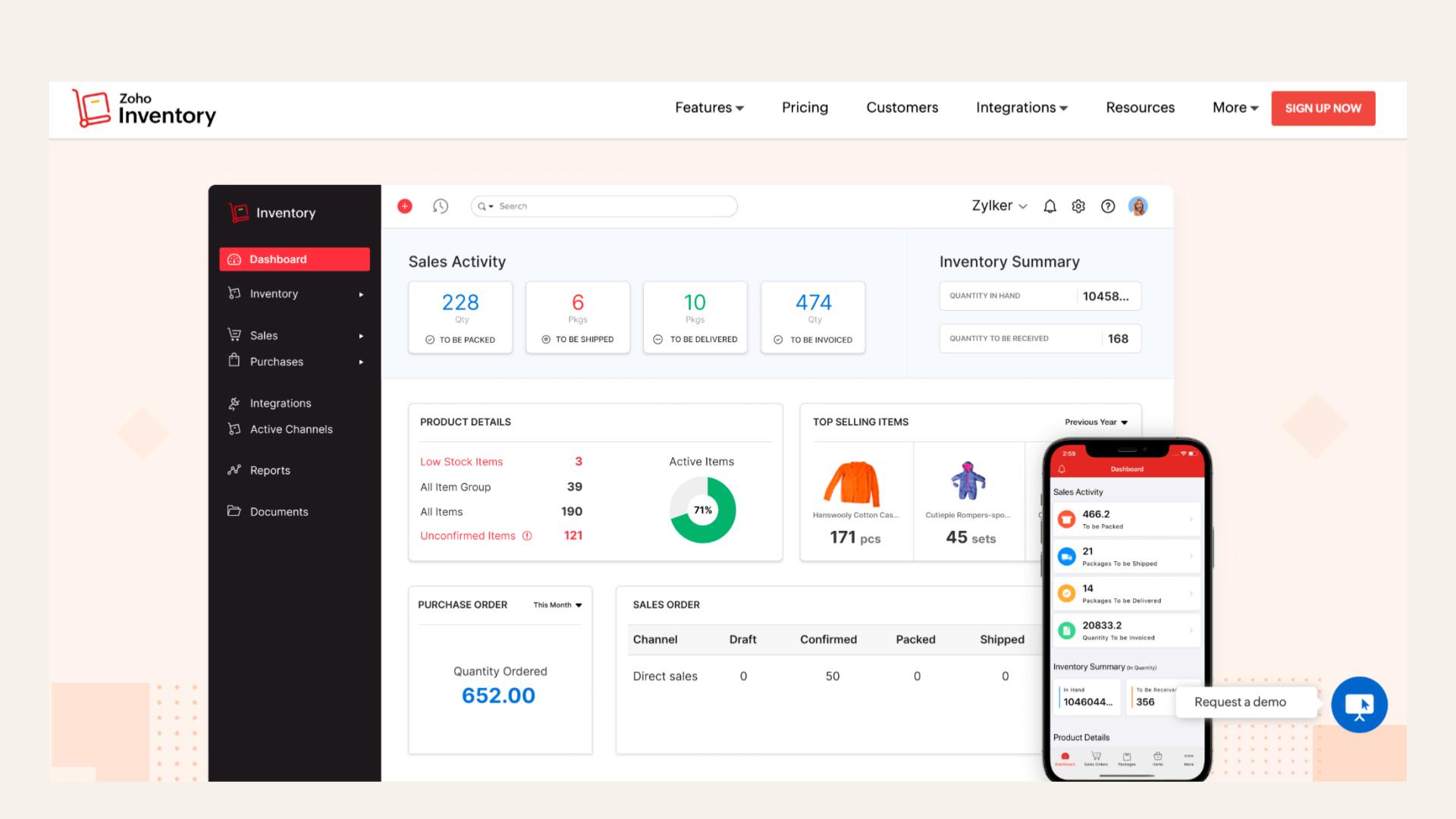
Zoho Inventory presents itself as a next-gen tool aimed at revolutionizing how businesses manage their stock levels, orders, and sales processes.
Being part of the extensive Zoho suite, it's designed to offer a comprehensive solution for inventory management that's both smart and user-friendly.
Key Features:
- Multichannel Management: Seamless integration with multiple sales channels for centralized order and inventory tracking.
- Warehouse Management: Keep tabs on your stock spread across different warehouses, optimizing storage and shipment.
- Automated Reordering: Set reorder points to ensure you never run out of stock, automating purchase orders when supplies dip below your set threshold.
- Real-Time Tracking: Monitor your inventory levels, sales, and order statuses in real-time, giving you a bird's eye view of your operations.
- Reporting and Analytics: Generate insightful reports to make data-driven decisions, understanding trends, and managing inventory more efficiently.
Best For:
Small to medium-sized businesses looking for a scalable solution to manage their inventory without the complexity.
It's particularly useful for retailers, e-commerce operators, and wholesalers who deal with intricate stock management and sales processes across various channels.
Plus:
- Integration Prowess: Excellent integration capabilities with other Zoho apps and major e-commerce platforms, streamlining operations.
- User-Friendly Interface: Easy to navigate, making it accessible for beginners without sacrificing depth for more experienced users.
- Affordability: Offers a competitive pricing model, including a free tier for small businesses just getting started.
Minus:
- Customization Limits: While it's versatile, some businesses might find customization options limited for very specific or unique operational needs.
- Learning Curve: New users may need some time to fully exploit its broad set of features.
3. Fishbowl Inventory
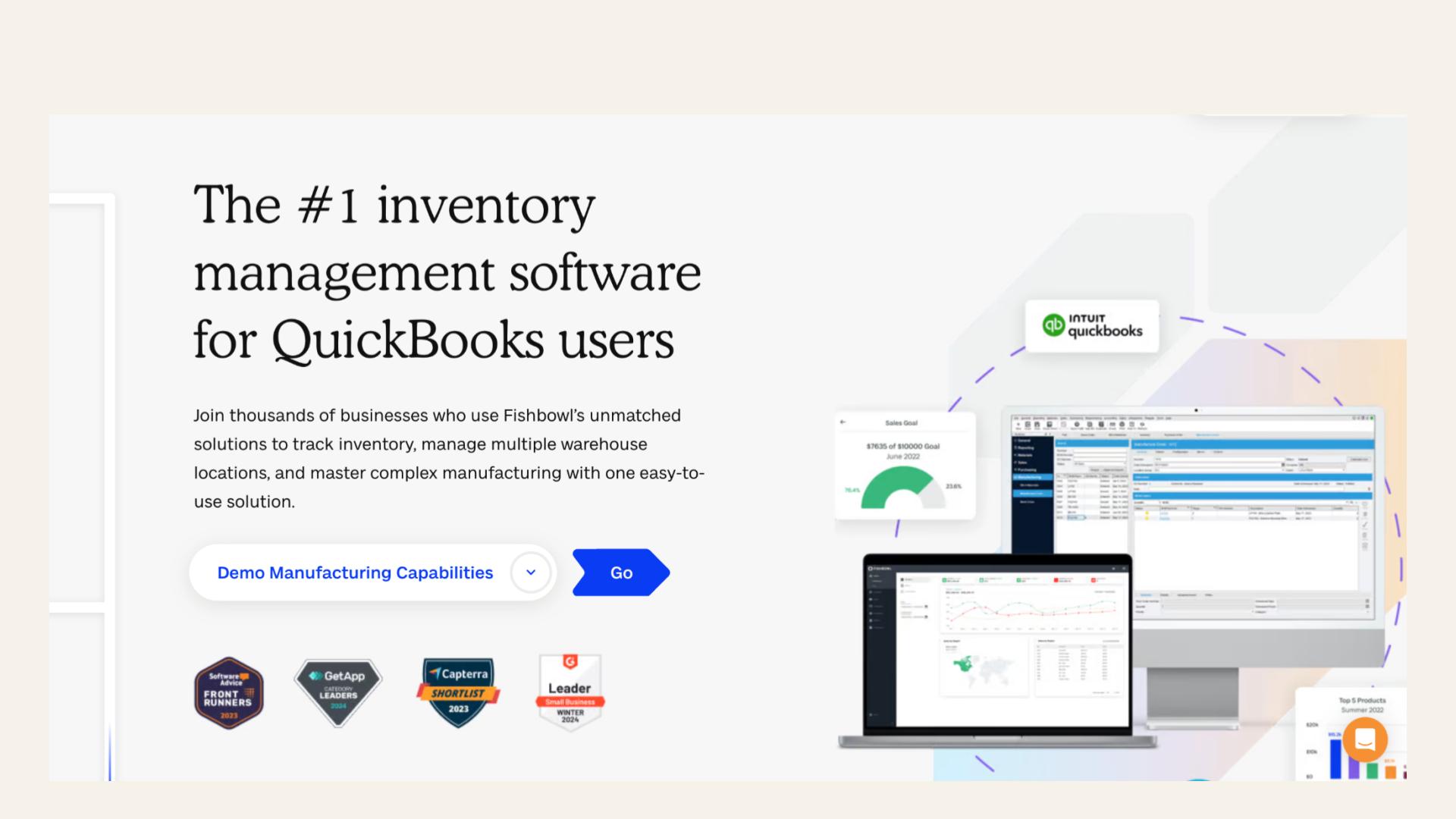
Fishbowl Inventory stands out as a comprehensive solution that supports various aspects of business operations, from inventory management to seamless accounting integration.
Fishbowl Inventory offers several software solutions tailored to different business needs:
- Fishbowl Advanced: A robust, on-premises solution for inventory tracking, warehousing, and manufacturing, with hosting capabilities.
- Fishbowl Drive: A cloud-based software solution for inventory and warehousing, accessible from anywhere.
- Fishbowl Commerce: An inventory management software integrated with powerful cloud-based eCommerce capabilities.
Key Features:
- Real-Time Inventory Management: Track inventory across all locations instantly, improving traceability and eliminating errors.
- Manufacturing Solutions: Manage simple to complex processes with features like Bill of Materials and Work Orders.
- Order Fulfillment: Efficiently handle sales orders, transfer orders, and returns.
- Multiple Integrations: Seamless integration with QuickBooks, allowing for streamlined accounting processes alongside inventory management.
- Comprehensive Reporting: Custom reports to track critical business metrics, enhancing decision-making capabilities.
Best For:
Fishbowl Inventory is ideal for small to medium-sized businesses in various industries who require robust inventory management, manufacturing, and warehousing capabilities. It is particularly valuable for those who already use QuickBooks or seek integration with other popular accounting software like Xero.
Plus:
- Versatility: Fishbowl offers solutions tailored for different needs, from cloud-based operations to extensive manufacturing processes.
- Integration: Strong integration with accounting software which is ideal for businesses already using these platforms.
- Customization: Ability to configure the software with custom reports, automated workflows, and specific user permissions.
Minus:
- Complexity: The wealth of features and options might be overwhelming for small businesses or those new to inventory management software.
- Cost: The advanced features and capabilities suggest that it might be on the higher end, potentially making it less accessible for very small businesses or startups.
4. Cin7
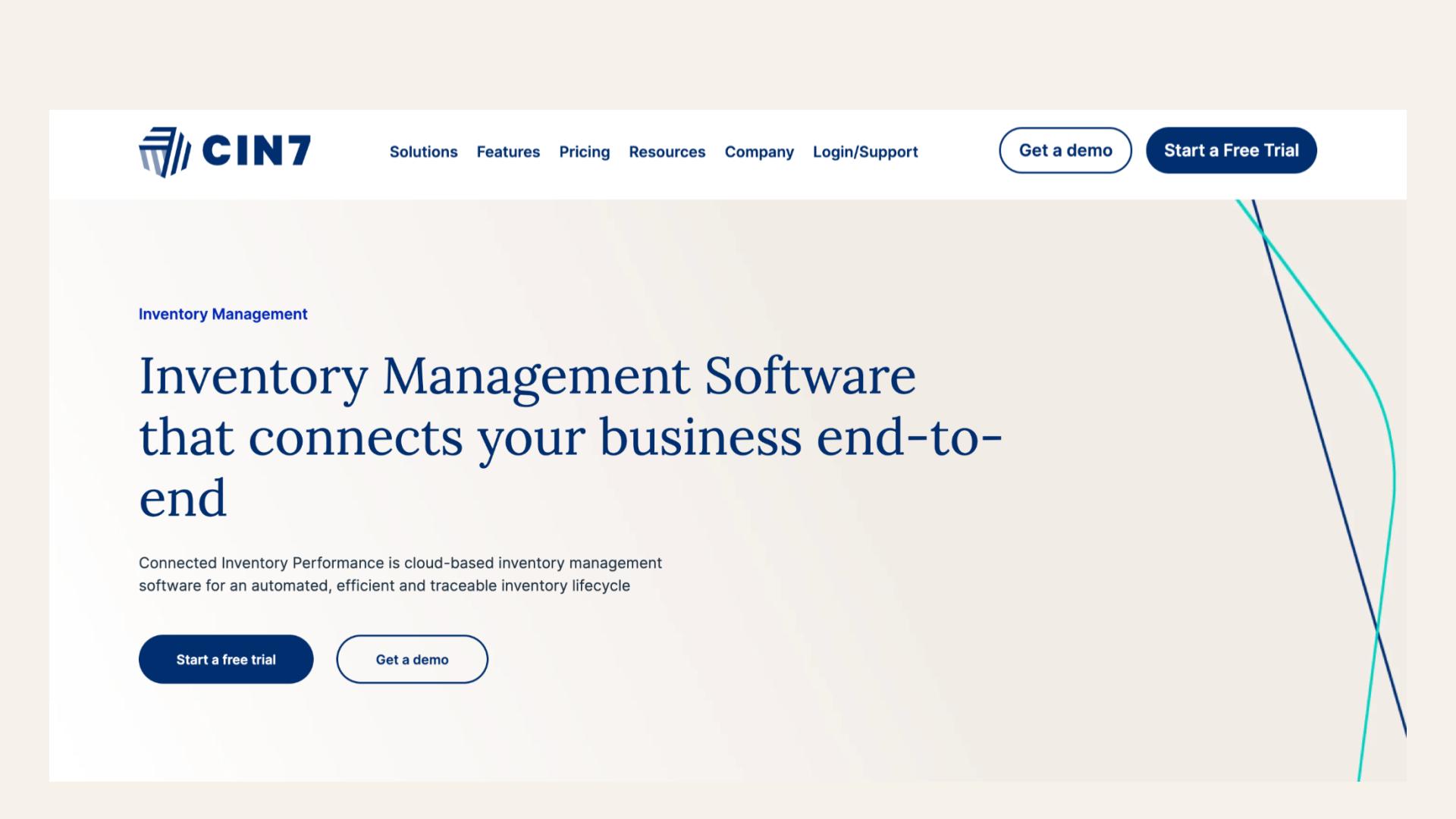
Cin7 is a cloud-based inventory management software that automates and streamlines the inventory lifecycle for businesses.
It provides real-time inventory insights and improves warehouse efficiency by handling purchase orders, storage, production, multi-channel sales, fulfillment, and returns—all from a single platform.
Key Features:
- Real-Time Inventory Insights: Offers visibility into every component and product throughout the end-to-end inventory operation.
- Improve Warehouse Efficiency: Streamlines pick and pack operations with barcode scanning and tracks transfers between various locations.
- Accurate Data Everywhere: Ensures access to critical data like actual Cost of Goods Sold (COGS), job costing, live stock levels, and reordering alerts.
- Manage Multiple Locations: Ideal for small businesses looking to keep their inventory organized across different locations and bins.
- Cost Accounting: Provides actual COGS, tax, and landed cost reporting with seamless synchronization to your accounting software.
- Business-Specific Needs: Allows customization of SKUs across sizes and colors, tracking of lot/batch expirations, recalls, and supports multiple price tiers for retail and wholesale customers.
Best For:
Cin7 is best suited for small to medium-sized businesses that require a robust, integrated system to manage inventory across multiple locations and channels.
It's particularly advantageous for businesses looking for scalability and those who operate both online and offline.
Plus:
- Versatile Integration: Cin7 integrates with over 40 popular software tools and supports custom API integration, making it highly adaptable to existing business ecosystems.
- Scalability: Designed to support fast-growing businesses, accommodating an unlimited number of SKUs, orders, and sales channels.
- Comprehensive Features: Offers a wide range of features that cover virtually every aspect of inventory management, making it a one-stop solution.
Minus:
- Complexity for Beginners: The breadth of features and depth of functionality may be overwhelming for absolute beginners or very small businesses that require a simpler solution.
- Pricing Transparency: Without clear pricing details available upfront, businesses may find it challenging to determine the cost without engaging in a demo or sales process.
5. Sortly
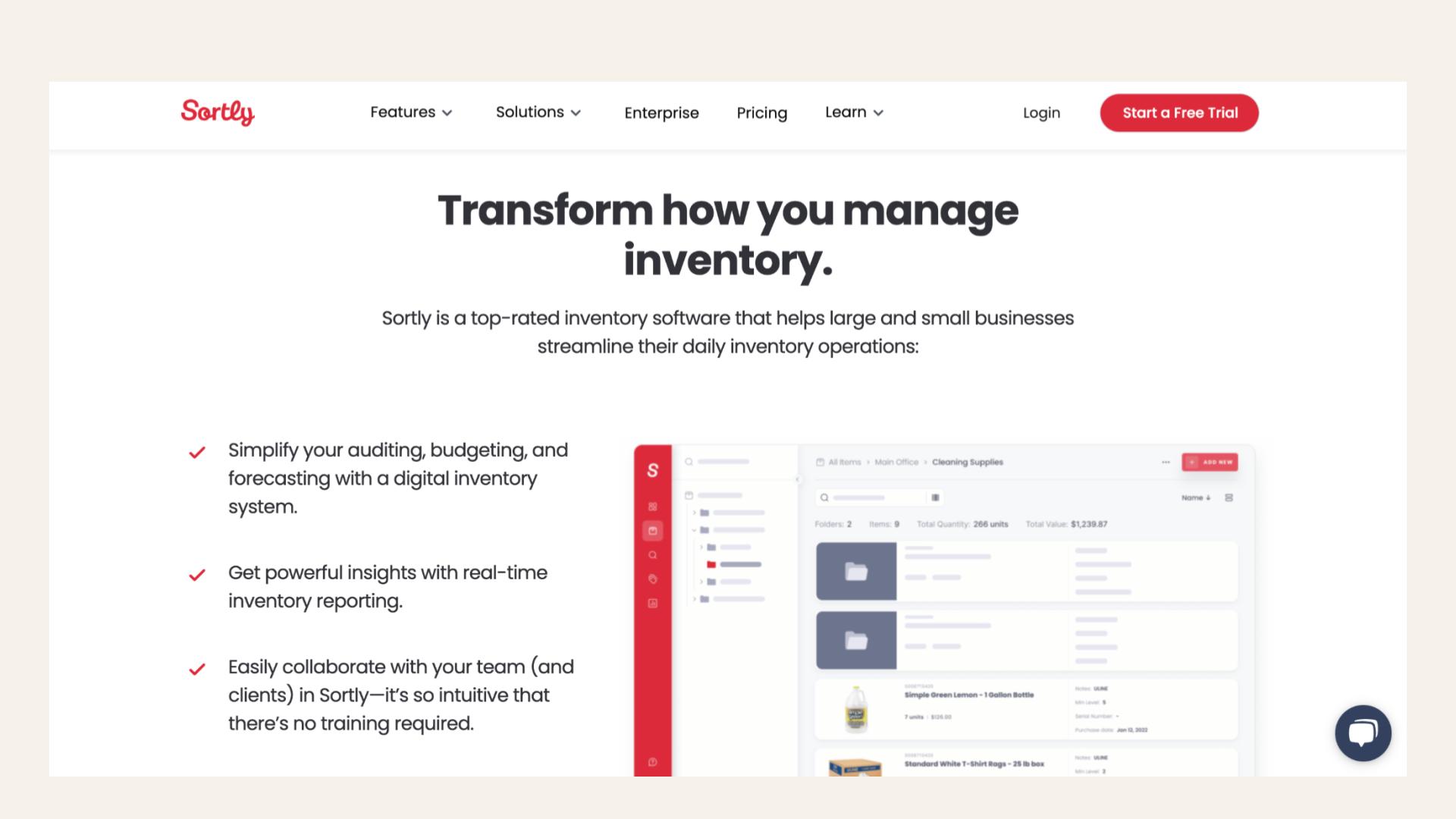
Sortly is an intuitive inventory management software that makes the process of tracking, organizing, and auditing inventory seamless.
Whether you’re managing supplies, materials, parts, equipment, or any other type of inventory, Sortly offers a clear and straightforward solution.
It's accessible from various devices such as smartphones, tablets, and computers, and caters to a wide array of industries including construction, medical, education, and non-profits.
Key Features:
- Mobile App: Track inventory from any location with the easy-to-use mobile application.
- QR & Barcode Scanning: Built-in functionality for QR code and barcode scanning and labeling to simplify inventory processes.
- Alerts: Customizable low stock and date-based alerts to help with reordering and maintenance schedules.
- Integrations: Compatibility with other platforms to streamline workflows.
- Reporting: Real-time insights through inventory reporting features.
- Custom Fields & Folders: Organize your inventory with bespoke categories and track unique item details.
- User Access Levels: Assign and customize levels of access to different team members.
Best For:
Sortly is ideal for small businesses seeking a user-friendly and cost-effective way to manage inventory.
It's also a great choice for larger businesses that require inventory tracking across multiple locations.
With its visual tracking capabilities, Sortly is particularly suitable for industries that need to maintain a visual catalog of items, such as interior design and staging.
Plus:
- User-Friendly Interface: Sortly is known for its simplicity, boasting an interface that requires minimal training.
- Versatility: Adaptable for various use cases, from tracking supplies to asset management and selling products.
- Time and Cost Efficiency: Helps businesses save time and reduce expenses related to inventory management.
Minus:
- Basic Features Structure: While Sortly is praised for its simplicity, businesses with very complex inventory needs might find it lacks some advanced features.
- Dependence on Digital Management: For businesses not accustomed to digital inventory management, the transition to Sortly’s system may require an adaptation period.
6. Ordoro
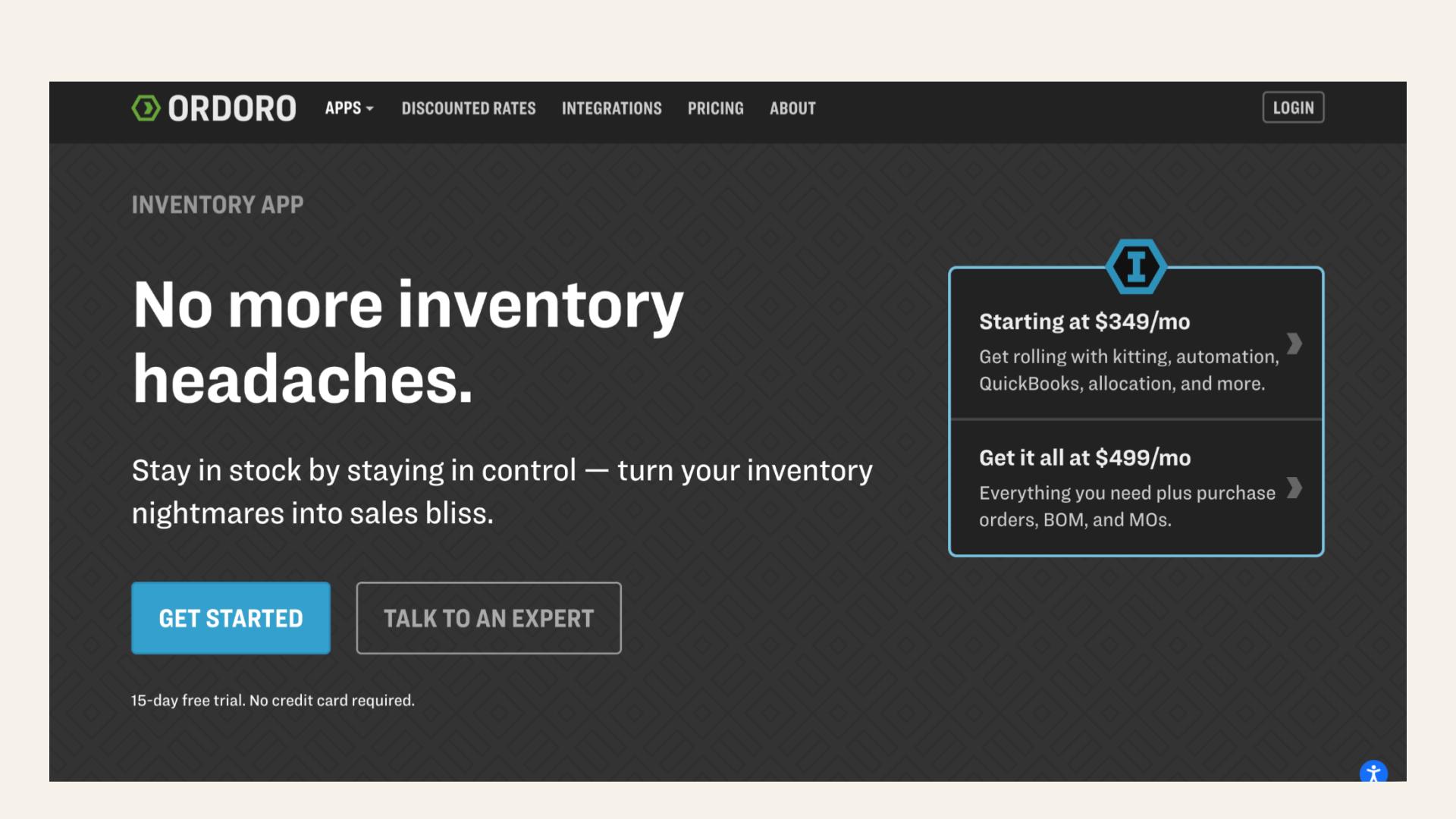
Ordoro is crafted to simplify inventory management for businesses. It’s not just about keeping tabs on stock numbers but ensuring these figures are accurately reflected across all sales channels, optimizing warehouse operations, and meeting customer demand efficiently.
Ordoro steps up by offering auto-syncing of stock levels, automated alerts for low stock, creation of purchase orders, and tracking goods receipts, among other features.
Key Features:
- Auto-syncing Stock Levels: Ensures inventory counts are consistent across all sales platforms in real-time.
- Automated Low-Stock Alerts: Get notified when stock levels are low to avoid overselling.
- Multi-Warehouse Management: Easily manage stock across several warehouse locations.
- Kitting and Bundling: Combine multiple SKUs into a single sellable unit for efficient inventory tracking.
- Open API for Integration: Allows seamless integration with various platforms for extended capabilities.
Best For:
Ordoro is an excellent match for eCommerce businesses and retailers looking to streamline their inventory across multiple channels or warehouses.
It's particularly beneficial for those keen on automating various aspects of their inventory management to save time and reduce manual errors.
Plus:
- Time-Saving Automation: With features like automatic inventory writeback, bulk uploads, and order routing, Ordoro significantly reduces the manual workload.
- Visibility and Control: Offering detailed insights into stock levels across channels, multi-warehouse management, and supplier lead times, Ordoro gives businesses a comprehensive overview of their inventory.
- Scalability: Its features are designed to support businesses looking to scale, offering everything from discounted shipping rates to advanced dropshipping management.
Minus:
- Complexity for Beginners: The vast array of features and capabilities may seem daunting to businesses new to digital inventory management.
- Potential Over-Features for Small Businesses: The extensive features designed for scalability might be more than what very small businesses or startups need initially.
7. NetSuite
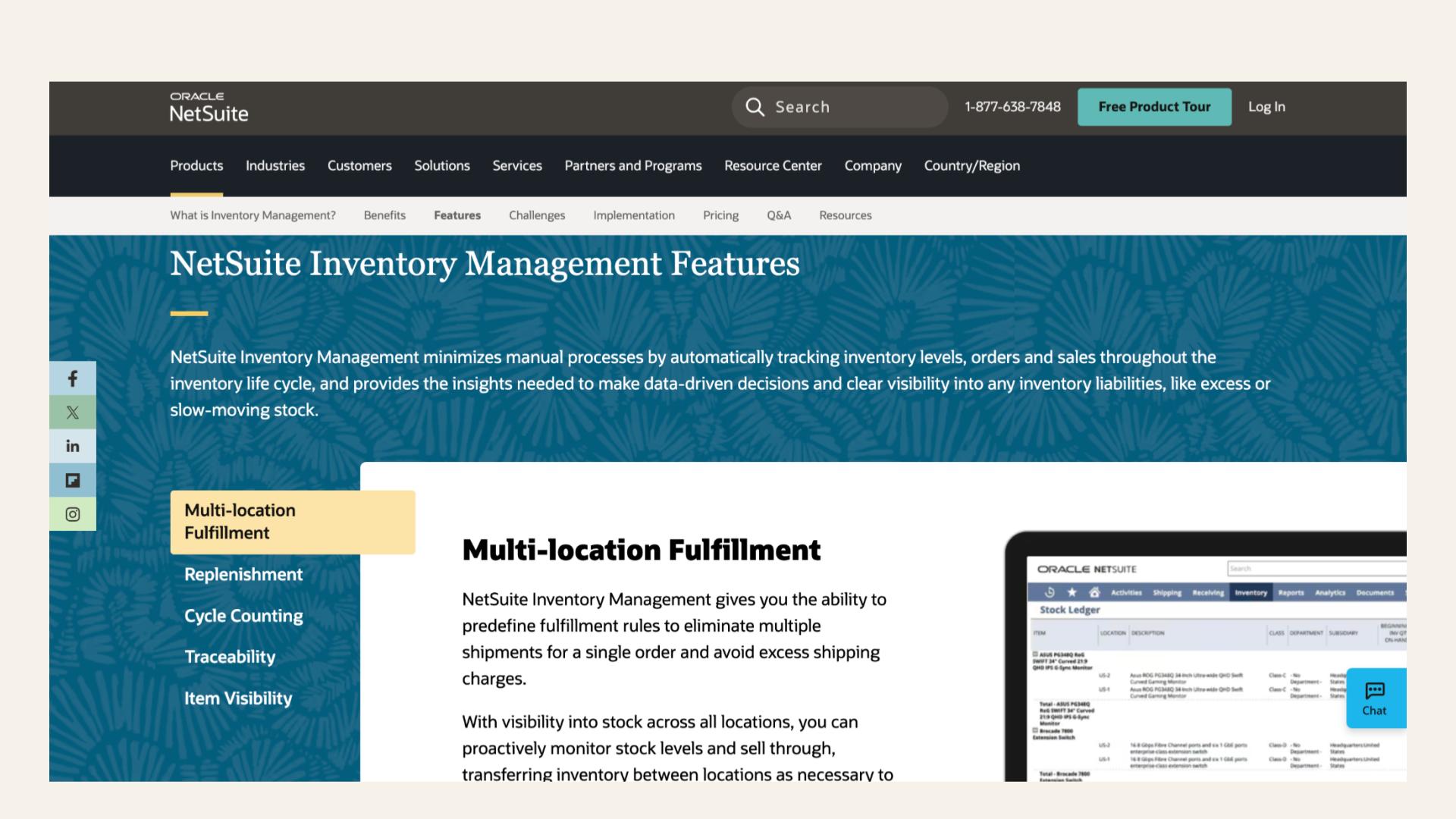
NetSuite Inventory Management provides an integrated approach to tracking and managing inventory across multiple locations and sales channels in real time.
It automates various inventory-related tasks and provides detailed insights into inventory levels, allowing businesses to optimize stock levels and reduce costs.
Key Features:
- Automated Inventory Tracking: Automates the process of inventory management, eliminating reliance on manual methods like spreadsheets.
- Ultimate Inventory Visibility: Provides real-time visibility across all channels and locations, such as warehouses, retail stores, and drop shippers.
- Multi-location Fulfillment: Allows predefined rules for fulfillment to minimize shipping costs and manage inventory efficiently across all storage points.
- Demand-based Replenishment: Uses sales forecasts and historical data to manage stock levels dynamically.
- Cycle Counting: Enhances the accuracy of inventory tracking with automated cycle counts without the need to halt operations.
- Traceability: Supports lot and serial number tracking for detailed traceability throughout the inventory lifecycle.
Best For:
NetSuite Inventory Management is particularly well-suited for medium to large businesses that operate across multiple locations or channels.
It is an ideal solution for companies requiring robust inventory management capabilities to support complex supply chains and dynamic sales environments.
Plus:
- Integrated Solution: As part of the broader NetSuite ERP system, it integrates tightly with other business functions like financials, CRM, and e-commerce.
- Scalability: Capable of supporting growing businesses as they expand in terms of product range and geographical reach.
- Insightful Reporting and Analytics: Provides powerful tools for forecasting and analyzing inventory levels, helping businesses make informed decisions.
Minus:
- Complexity: The breadth of features and integration power might be overwhelming for very small businesses or those with simple inventory needs.
- Cost: Being a comprehensive ERP solution, the cost may be higher compared to standalone inventory management systems, potentially putting it out of reach for smaller enterprises.
8. InFlow Inventory
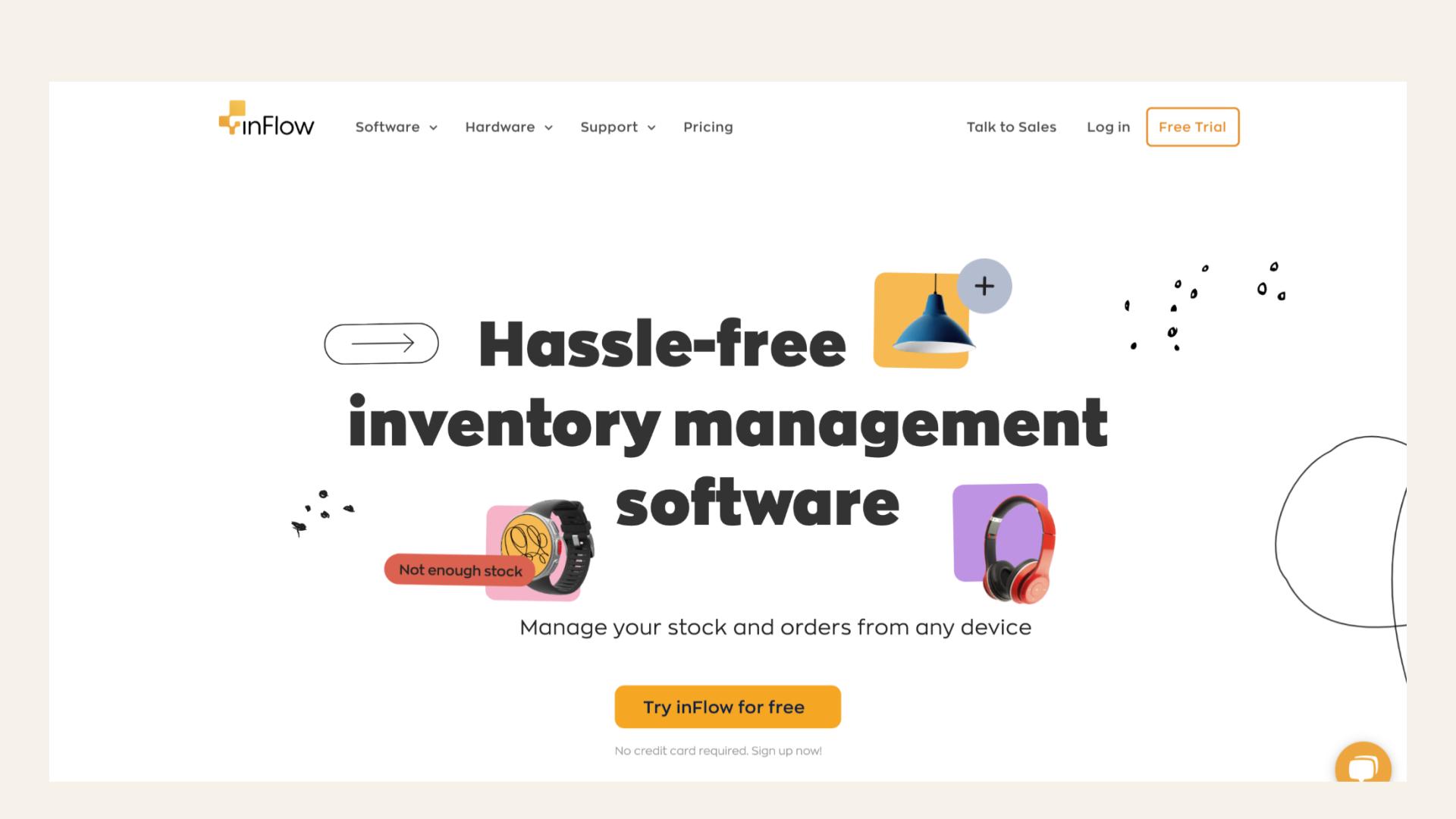
InFlow Inventory is an inventory management software system designed to simplify the complexities involved with inventory, orders, and sales.
It is a versatile tool that caters to a wide range of businesses, helping them keep track of products, manage purchases, create barcodes, and generate detailed reports.
Key Features:
- Inventory Control: Streamlines managing stock levels, helping businesses save money and reduce waste.
- Purchasing & Receiving: Facilitates sending purchase orders (POs) and receiving products efficiently from any device.
- Barcoding: Allows for the generation of barcodes, making scanning and tracking of products effortless.
- Reporting: Offers over 30 different reports to get insights into business operations and inventory status.
- Manufacturing: Supports creating assemblies or kits while keeping an accurate track of costs.
- Sales & Invoicing: Integrates quoting, picking, shipping, and invoicing in one seamless process.
- Mobile App: Enables users to perform crucial inventory tasks and access information from smartphones.
- B2B Portal: Provides a platform for taking B2B orders online without the need for a separate eCommerce store.
- Integrations & API: Connects with various online sales, accounting platforms, and more, for streamlined operations.
Best For:
Small to medium-sized businesses looking for an all-in-one solution to manage inventory, sales, and purchase orders across various industries such as retail, wholesale, manufacturing, and eCommerce.
It is also suit the best for businesses requiring a robust system for barcoding and product tracking.
Plus:
- User-Friendly: InFlow is designed with ease of use in mind, making it accessible for beginners and experienced users alike.
- Versatility: Caters to a wide range of business needs, from warehouse management to field service tracking.
- Comprehensive Reporting: Extensive reporting capabilities help businesses make informed decisions.
- No Credit Card Required for Trial: Businesses can try the software for free without any financial commitment.
Minus:
- Learning Curve: While InFlow aims to be user-friendly, the breadth of its features can mean a steep learning curve for some users to fully utilize all its capabilities.
- Potential Overhead for Small Operations: For very small businesses or those with minimal inventory management needs, the system may offer more functionality than necessary, potentially leading to unneeded complexity.
Conclusion
Picking the best inventory management software is like choosing the right travel buddy: it needs to match your style, keep up with your pace, and handle the heavy lifting without breaking a sweat.
Choosing the right inventory management software comes down to understanding your business size, needs, and growth potential.
Each of these platforms offers unique strengths and weaknesses, so consider what’s most important for your operation.
Whether you're a small café owner or a rapidly scaling eCommerce site, there's a solution out there that fits your specific inventory challenges. Happy organizing!







